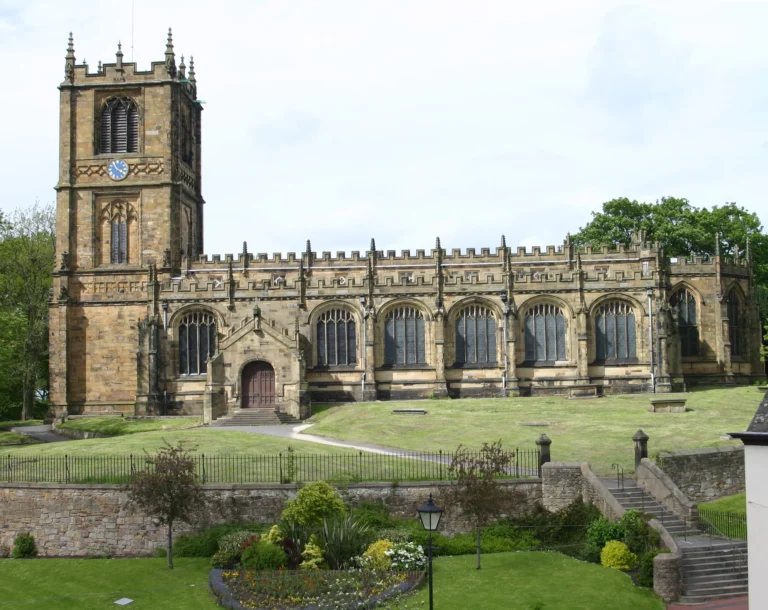
A Brief Description of the Parish Church of St Mary the Virgin, Mold
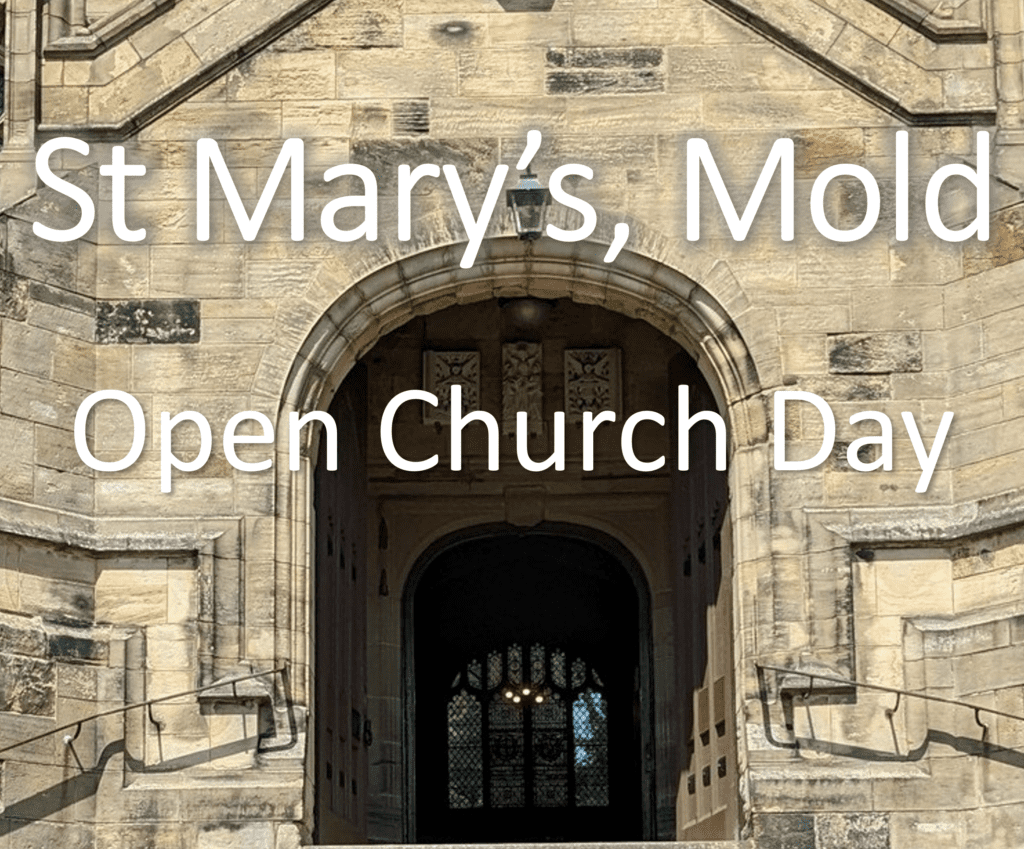
The present church of St Mary the Virgin stands on the site of an earlier church built in the 12th or early 13th century. The construction of the present building was initiated by Margaret Beaufort, Countess of Richmond, to commemorate the victory of her son, Henry Tudor, at the Battle of Bosworth Field in 1485. There were adaptations and additions over the years, including the chancel area (where the main Altar is) and the present bell tower. Click here for more information.
We warmly welcome visitors to St Mary’s – as well as checking out our Events Calendar, do ask about our next Open Church Day, Open Mornings or contact us for a tour of the church.
NEW PLANS FOR ST MARY’S CHURCH
St Mary’s
Plans are presently being developed and consulted on to add an extension to the church to provide modern facilities as well as some sensitive additions within the building to enhance peoples enjoyment of this beautiful Grade I listed building. These plans can be seen here.
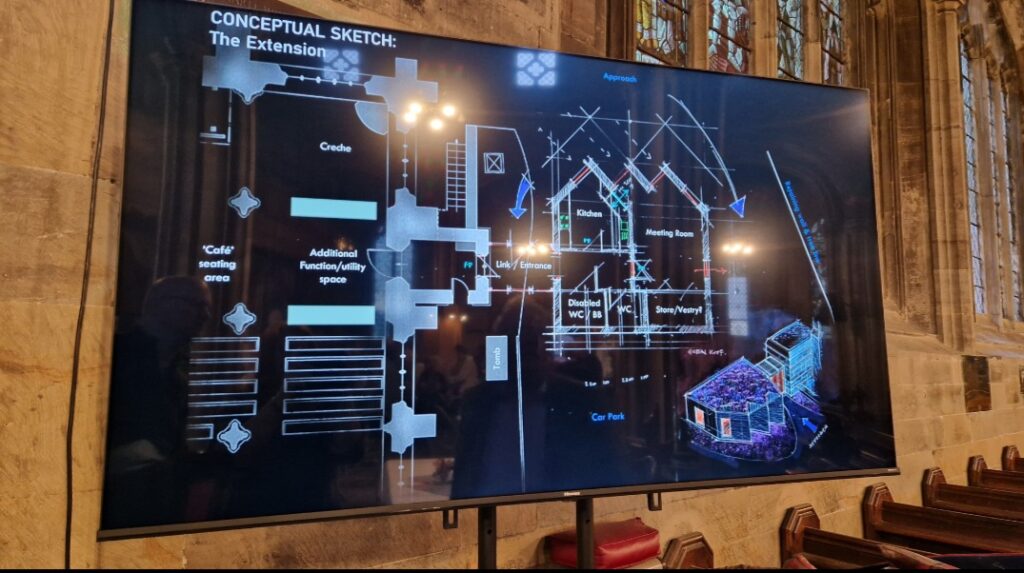
Multi Media – using screens to help engage and communicate the latest, exciting new reordering plans for St Mary’s
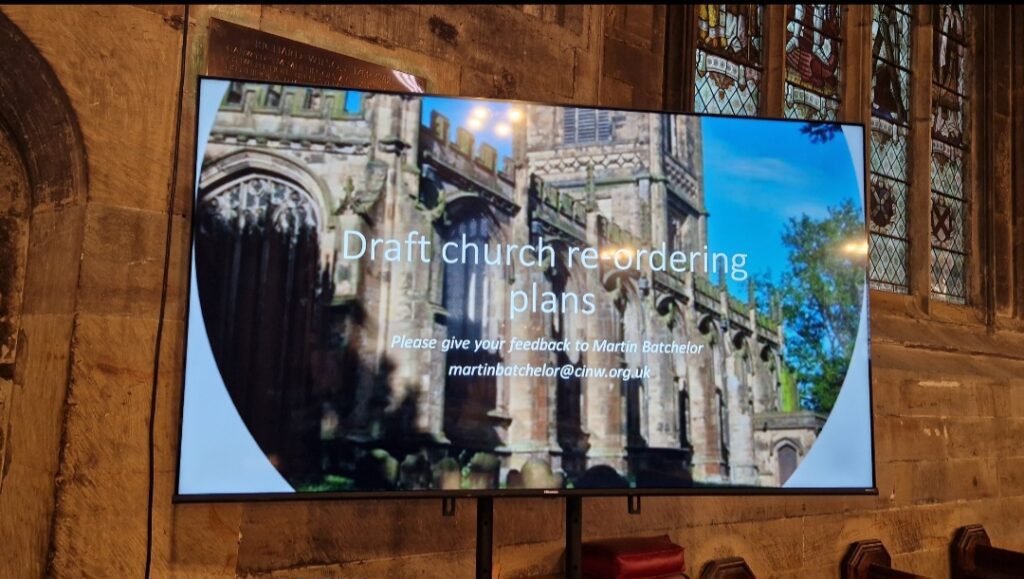
Coming Soon…
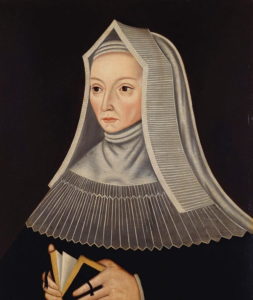
Lady Margaret Beaufort, Countess of Richmond and Derby
Come back soon and catch a short visual montage of Henry Tudor’s mother, set to Greensleeves-a much loved favourite-especially in the Medieval era. Also, close ups of our beautiful carved features and incredible stained glass windows…
HISTORY OF ST MARY’S THE VIRGIN, MOLD
Two buildings dominated Mold in the 13th century, the Norman Castle on Bailey Hill and the Church. Of unknown date, that earlier church is mentioned in the Norwich Taxation of 1253. The present building arose at a decisive watershed in British history, the emergence of the Tudor Dynasty with the accession of Henry Tudor as Henry V11 following the battle of Bosworth Field in 1485. Henry’s mother was Margaret Beaufort, Countess of Richmond. She was the second wife of Lord Thomas Stanley, Lord of the Manor of Mold and an extensive landowner in North East Wales. Margaret Beaufort was wealthy, learned and devout. She and her husband endowed colleges in Oxford and Cambridge and were responsible for the “Stanley” Churches at Mold and several nearby parishes.
Entering the South door we can feel the emphasis and importance which the 15th Century builders placed on space and light, the special qualities of the Perpendicular style. The 1856 font is surmounted by an 18th Century ironwork cross. The west window was erected by William Marston of Bromfield Hall, who was in service to the Duke of Tuscany in the 1848 Italian revolution. Looking down the length of the Nave we can appreciate the graceful, clustered columns, surmounted by elaborately carved quatrefoils and panelling. Between the spring of the arches are angels bearing the emblems of Christ’s passion and Stanley emblems and badges; the Eagle’s Claw, Legs of Man and the Eagle and Child. The curious string-course of animals running above the arches appears also on the outside of the Church. The splendid nave roof was made by a local craftsman, Thomas Edwards, for the 1856 Gilbert Scott restoration, as were the carved pews. The marble monument to Robert Davies of Llanerch, in the North West corner, is an impressive example of 18th century neo-classicism.
The North Aisle retains its original magnificent late 15th Century oak roof. The left window above the vestry door commemorates Ellis ap David ap Rees, a Vicar of Mold who died in 1576. Edward, the 3rd Earl of Derby, commemorated in the other window was Chamberlain of Chester under Elizabeth 1. The next composite window to the right of the Vestry door is in memory of Richard Wilson the celebrated landscape artist who died in 1792 and is buried outside this window. The next two windows relate to the Wynne Eyton family of Leeswood Hall. The Lady Chapel (also a memorial to the fallen of the 1914- 18 War) contains a beautiful late 15th Century niche with an early 20th Century statue of Our Lady, but it may once have held “Y Ddelw Fyw” (“The Living Image”) which, when the Norman Tower was taken down in 1768, was discovered buried and destroyed on the instructions of the then Vicar as representing “a Popish Idol”.
The great Chancel arch marks the furthest extent of the original Stanley Church. The door in the South wall of the Sanctuary, leading to a staircase, may imply that an upper room was planned, or a Rood Screen. There is also evidence, more noticeable on the outside, that the original Chancel was intended to extend further to the East. The present Sanctuary was added by Sir George Gilbert Scott in 1856. The organ, built by Rushworth and Dreaper of Liverpool was dedicated in 1972 and its outstanding tonal qualities have won it world-wide acclaim. It replaced an organ built by the same company in 1923. The organ case on the West wall is now redundant.
The South Chapel or St John’s Chapel (known also as the Gwysaney Chapel) has a special air of tranquillity. The carved stone niche to the right of the east window is particularly fine. The small brass memorial to Robert Davies, who died in 1602, came from Gwysaney Hall Chapel. Against the South wall can be found a fragment of the tomb of Gwenllian whose father, Ieuan ap Dafydd, did homage to the Black Prince in 1301. The first window in the South wall (in memory of Philip Davies Cooke of Gwysaney) shows Christ healing both body and mental suffering. The next window (The Parable of the Talents) commemorates Henry Raikes of Llwynegrin Hall, whose uncle, Robert Raikes, founded the Sunday School movement. The window in memory of John Wynne Eyton portrays the parable of the Sheep and the Goats, followed by a window commemorating Cecil Henry Raikes, MP, and First Secretary of the Mersey Railway Company. The window to the left of the South door contains fragments of the original glass.
In harmonious blend with the rest of the building, the tower was designed by Joseph Turner of Hawarden and built in 1773 to replace the original Norman tower. A peal of six bells was cast by Rudhall of Gloucester in 1732 and augmented to a ring of eight in 2005 with the addition of bells cast at the Royal Eijsbouts bell foundry in the Netherlands.
The present church of St Mary the Virgin stands on the site of an earlier church built, presumably by the Montalts sometime during their Lordship of Mold in the 12th or early 13th century. Records from the Norwich Taxation of Ecclesiastical Property show that a church of some sort did exist in Mold in 1253 and named Kenric as Rural Dean and probably also Rector of Mold at this time.
The building of the present church was initiated by Margaret Beaufort, Countess of Richmond, to commemorate the victory of her son, Henry Tudor, at the Battle of Bosworth Field in 1485. Previously, in 1482, Margaret Beaufort had married Thomas Stanley, Lord of Mold, King of Man, and at that time, Steward of the Royal Household. Margaret became his second wife, while he was her third husband. Lord Stanley played a dubious part in Henry’s campaign for the English Crown, seemingly preferring to wait for a clear indication of who was most likely to win before declaring his own position. Henry Tudor met Richard III in battle at Bosworth Field, near Leicester, and after some cautious hesitation, when Richard’s cause seemed totally lost, Lord Stanley eventually joined his stepson , and tradition has it that he picked up the fallen crown and placed it upon Henry’s head.
Margaret Beaufort at Prayer
Lord, Stanley, as just reward for his pains, added the Earldom of Derby to his already considerable possessions in Wales and the Isle of Man. In thanksgiving for their good fortune, Lord Stanley and Margaret Beaufort endowed colleges at Oxford and Cambridge and undertook the rebuilding of several churches including St Mary’s Mold.
Other Churches in North Wales accredited to them are St Peter’s in Northop, All Saints Gresford, St Giles Wrexham and St Winifred’s Chapel in Holywell. The Stanley involvement is highlighted in by the number of Stanley crests and arms to be found in the churches. Lord Thomas Stanley was the last to call himself King of Man. Thereafter the Lords were called Lord of Man.
The Stanley Crest
The rebuilding of St Mary’s was never completed as originally intended. The proposed tall grand clerestory was thought to be too extravagant and was abandoned in favour of the shallow uninspiring clerestory that can be seen today. A grand chancel arch was built, but due to financial and political restrictions it remained blocked until opened by Scot in the nineteenth century. Rebuilding the Church was a slow business and continued well after the Reformation with contributions made by Robert Wharton, Bishop of St Asaph (1536 – 1554) and William Hughes, Bishop of St Asaph (1572 – 1600).
However, even with this input the completion of the church took a further 8 years.
F J Violet, writing in his Mold Gleanings in 1927, refers to the stone in the church carrying the inscription Fundamentum Ecclesiae Christmas 1597 – W. Eps”, which implies that the church was eventually completed, albeit a somewhat abbreviated version of the proposed, more extravagant structure, in 1597, well over a century after rebuilding had first begun!
The main body of the church was built in Cefn Sandstone in the late 15th Century, but without apse and porches. There was originally a 5-lighted central east window and a wrought iron rood screen.
The interior of the church had an earth floor, open fireplaces or stoves and was disfigured by many and various box pews. There was also an unsightly musicians gallery at the west end. Some burials took place within the church and benches were allocated for the poorer classes next to the outer walls.
There are a great number of entries in the accounts regarding payments made to builders and carpenters for necessary maintenance work over the years, as one might expect, but it is only in 1742 that the results of a thorough structural survey show just how serious the situation had become. The record of the Vestry Meeting dated December 27th 1742 states:
“A survey has been taken and a report made that the roofs of the middle and south aisles are much decayed and in a dangerous condition and that the expense of repairing them would be very considerable and above what the inhabitants of the said parish can afford.”
It is interesting to recall that only 5 years previous to this report the church accounts for 1737 recall:
“whereas a sum of £95, being several benefactions for the use of the poor, also a sum of £50 were advanced and lent to the parishioners to enable them to make a new middle roof to the church”.
One can only hope that the roof was in fact repaired promptly after the survey revealed it to be dangerous, but other work was obviously neglected. For instance, the Rural Dean’s report in 1749 includes:
“The church is a stately building consisting of 3 larges aisles, but a very poor steeple some part of which is on props”.
The Tower
The “very poor steeple” referred to in the Rural Dean’s report of 1749 may well have been a Pre-perpendicular one, perhaps a remnant from the earlier 12th Century church. Church records show that this tower along with the fabric of the whole church was giving rise to some anxiety. In 1768, some 20 years after the Rural Dean’s report the tower was eventually demolished and the present tower was built during 1768-73 by Joseph Turner, an architect who lived at The Elms in Hawarden and who was responsible for Bridge Gate on Lower Bridge Street in Chester, the County Gaol in Flint and the old gaol at Ruthin.
Turner created a tower in the Perpendicular style to match the simple elegance of the existing church. He used the same buff coloured Cefn sandstone as had originally been used and he even continued the procession of carved animals around the tower so as to further blend the old with the new.
The tower incorporated a peal of 6 bells by Rudhalls of Gloucester which had been cast 40 years previously.
Restoration
Sir George Gilbert Scott’s Restoration 1856
A major restoration took place in 1856 under the direction of Sir George Gilbert Scott, a well established master of the Gothic revival. He removed the east wall, thus opening up the Chancel Arch beyond which he created a chancel consisting on one bay and a three sided apse, having taken his cue from two other Lady Beaufort churches, St Giles Wrexham and St Winifred’s Chapel Holywell. Thus he hoped to build a chancel as it might have originally been built back in the 15th Century.
Scott also organised the restoration of the central aisle roof and in an attempt to reinstate its Gothic integrity he modelled his new roof on the style of the original 15th century roof which still remained over the north side. The earlier restoration in the 18th century had merely given the church a contemporary roof without an architectural style, though as we are now well aware, only limited funds were available at the time. Reversing such transmutations on architecture style was one of the primary driving forces of the Gothic revivalists who were rampant in North Wales during the latter half of the 19th Century. Although Scott is accredited with the restoration of the roof, the work was actually carried out under his guidance by a local craftsman, Thomas Edwards, in 1857. However, by 1874 the central roof was again giving cause for concern, with Sir Gilbert Scott’s reputation at stake one can only assume the roof was repaired promptly.
In summary Gilbert Scott’s work consisted of: the East Wall was opened up and he built a five sided apse with five windows; Chancel and Sanctuary tiled with encaustic tiles; the rood screen was replaced and the external spiral staircase to the roof is now entered from inside the church; the box pews were removed and a wooden floor added, as were the pews, choir stalls and reading desks; the aisles were stone flagged. The carved roof over the centre aisle was added to match the original 15th century north roof. All this carved oak and woodwork was carried out by the local craftsman Thomas Edwards between 1857 and 1874. Porches were built over the North and South entrances, but the more ornate porch on the south entrance with its stone vaulted roof, is probably 17th Century, but was made Neo-Perpendicular when it was restored by Prothero, Phillott and Barnard in 1911. The Font was moved to its present position. The majority of the Stained Glass windows were introduced during this restoration period. A new organ was built which completely filled the area of the Lady Chapel.
20th Century Restoration Works
In 1911 the porch at the South entrance with its stone-vaulted roof was made Neo-Perpendicular when it was restored by Prothero, Phillott and Barnard in 1911.
In 1921 the 19th Century organ was replaced by one whose pipes were housed in a case which is still standing at the west end of the nave. The resulting reduction in size of the choir organ case allowed the restoration of the Lady Chapel in 1921 by Sir Thomas G Jackson. The chapel was restored in memory of the men of Mold who fell in the 1914-18 War.
Discovery by cleaners of dead beetles on the pews presaged the 1950’s restoration. All the wood had to be treated for beetle damage. The wooden floor of the nave was removed and the floor beneath the pews was concreted. Pews that were badly damaged by beetle and woodworm were destroyed. The surviving pews were returned to the nave and in a re-designed seating area. The reduction on the number of pews resulted in the opening up of the Gwysaney Chapel on the south side of the Church. The roof was re-leaded and the floors in the aisles were stone-flagged.
The outside of the Church was also radically altered. Most of the old box tombstones and headstones were removed as they had become unsightly with age and difficult to maintain. The entire area was re-lawned and the present stone wall rebuilt because the old retaining wall was exposed by the demolition of buildings and road widening of the High Street.
One box tombstone of particular interest marks the grave of Richard Wilson RA, who has been called the father of British landscape painting.
The latest restoration carried out between 1998 and 2001 comprised the following works: repairs to the roof over the chancel and sanctuary; re-roofing of the area over the nave and repair of underlying woodwork; re-leading of the sanctuary windows and also windows in the south side of the nave; replacement of old window guards and introduction of guards to windows previously unprotected; installation of a comprehensive sound enhancement and amplification system with an induction loop; complete re-pointing and repair of the stonework in the tower.
In 2005 the original peal of 6 bells was increased to 8. On Thursday 15th September at the Royal Eijsbouts Foundry at Asten in Holland 2 new bells were cast to bring the ring up to a peal of 8. A new treble bearing the name “Melangell” is the gift of the Rev’d Canon John Whelan and the new tenor bearing the name “Cloch y Clochganwyr” (Ringers’ Bell) is the gift of the ringers themselves. The foundry had also recast a replacement of our existing tenor (the new 7th). This bell was cast later than the original 1732 bells and has proved to be of extremely poor quality. Its replacement or “recast” carries a facsimile copy of the original inscription together with the current date and names of the Vicar and Churchwardens. The new peal was dedicated by Bishop John Davies, Bishop of St Asaph, following the Confirmation service on December 4th, 2005.

The stained glass, like so much else in the church, is of excellent quality. This section contains a brief description of the stained glass, beginning in the chancel and then continuing in a clockwise direction around the nave. The plan of St. Mary’s above bears numbers which correspond with those in the text below.
THE CHANCEL
The apse was added by Sir Gilbert Scott in the mid-1850’s. The five three-light stained glass windows were made by William Wailes of Newcastle-upon-Tyne, c. 1856 in neo-Gothic style, with strong jewel-like colours which are very striking when viewed from the nave.
1 The first window on the left (north) side was erected in memory of F C Philips of Rhual and shows vine branches and scrolls.
2 The next window was presented by J W Eyton of Leeswood Hall and shows above the Annunciation, Nativity and Circumcision, and below the Wise Men, Christ as a boy in the Temple and his Baptism by John.
The other three windows in the apse were erected in honour of C B Clough, Vicar of Mold 1825-1854, who engaged Scott to restore and re-pew the church. The subjects are as follows:
3 Below Jesus’ triumphal entry into Jerusalem, Last Supper, Gethsemane, and above Christ carrying the cross, being Crucified and placed in the tomb.
4 Below the Resurrection, Jesus appears to Peter (with key) “feed my sheep”, and to the disciples, and above — Jesus’ ascension, Christ in Glory, the coming of the Holy Spirit at Pentecost.
5 More vines with scrolls, balancing window#1.
THE NAVE — SOUTH AISLE
6 The five-light window at the cast end of the south aisle shows Christ and the Four Evangelists – Matthew, Mark, Luke and John (note the pens and books they hold). It was erected in 1863 and was again made by Wailes. Below are scenes showing Christ healing the paralysed man, the three Marys at the tomb, the raising of Lazarus, Peter raising Dorcas (Tabitha) and the Christ healing the blind man.
7 This window was made by another famous Victorian stained glass firm, Clayton & Bell, in 1872, with characteristic elaborate canopy work above each scene and depicting Mary Magdalene anointing Christ’s feet, the Prodigal Son being welcomed by his father, Christ healing the leper and Christ promising to raise Lazarus.
8 This was designed by another leading firm, Lavers & Barraud, in 1864. It shows eight scenes illustrating the parable of the Talents, in memory of Henry Raikes of Llwynegrin. This is a highly decorative window and the individual panels are well worthy of detailed study.
9 This is another fine window by Clayton & Bell (1876) and illustrates Christ’s description of the last judgement – “I was thirsty and you gave me drink; I was naked and you clothed me; I was a stranger and you welcomed me; I was in prison and you visited me.” (Matthew 25:31-end)
10 The next window has in the past been wrongly attributed to Edward Burne-Jones, though it does show Pre-Raphaelite influence, It is in fact a notable example of the work of Alexander Booker (1891) and shows Angels appearing to the Virgin Mary (Annunciation), to the Shepherds after the Nativity, to Joseph telling the Holy Family to go to Egypt and to Mary Magdalene outside the empty tomb.
11 The window immediately adjoining the entrance porch contains numerous fragments of medieval and Tudor stained glass from earlier windows, now lost. Some of the fragments were by the York school of painters.
12 The window on the other side of the porch is plain.
13 The west window in the south aisle is an elaborate window of 1868 in the style of William Wailes but of inferior workmanship and possibly by R B Edmundson of Manchester. The theme is “Water & Baptism”, showing from left to right: Moses striking the rock to obtain water, the baptism of Christ in the Jordan, Christ teaching the children, Christ with the Samaritan woman at the well and Christ telling Nicodemus that he must be born again of water and the spirit.
THE NAVE — NORTH AISLE
14 The west window in the north aisle, and
15 The western-most window in the north aisle, contain a few small fragments of insignia relating to the Stanley family.
16 This window above the vestry door has some interesting heraldic panels commemorating a vicar who died in1576 and the third Earl of Derby who died in 1572. It includes a rare example of Renaissance design with balusters, garlands and sea monsters. Note the “Legs of Man” in one of the roundels.
17 This has representations of the four patron saints of Wales, England, Scotland and Ireland: St. David, St. George (in armour), St. Andrew (with cross) and St. Patrick. This window was made by the well-known firm of Burlison & Grylls between 1889 and 1924 and is in memory of the famous painter, Richard Wilson, who is buried in the churchyard by the vestry door.
18 A plain leaded window.
19 This window by Clayton & Bell (1870) shows the prophets Isaiah, Jeremiah, Ezekiel, and Daniel. Again note the elaborate canopy work.
20 This window, showing Saints Peter, Matthias, Stephen and Paul was made by William Wailes in 1865. The scenes below depict: Jesus calling the Apostles; the Apostles choosing by lot Matthias to fill the vacancy in the Apostles caused by the death of Judas Iscariot; the Apostles ordaining Deacons and the Apostles commissioning Paul and Barnabas. The first of these panels (bottom left) was damaged by stone-throwing and was repaired by H Griffiths & Sons of Chester in 1993.
21 and 22 are plain. As part of the 1850 s restoration a new organ was built and its casing filled the area of the Lady Chapel. Windows 21 & 22 were thereby hidden from view from within the church and therefore were not filled with stained glass. In 1922 the organ was replaced which allowed the present Lady Chapel to be constructed as a memorial to the fallen of the 1st World War. The plain leaded windows allow light to flood into the chapel giving a most tranquil air to this part of the church.
Research and text by Dr Malcolm Seaborne 1999 with some additional notes by The Revd Ian Day former Vicar of Mold